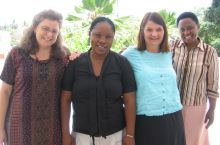
I am always amazed by what happens when people with a shared passion come together. In this case the people are members of the Canadian Association of Midwives (CAM) and the Tanzanian Midwives Association (TAMA); the shared passion is about ensuring that girls, women and newborns have access to quality midwifery care – care that can save their lives.
It all began with a Twinning Project conceived by the International Confederation of Midwives in 2011– essentially an exchange of mentorship, and capacity building support between CAM and TAMA. Since that time, both associations have seen remarkable results in terms of increased capacity to serve our members, and to advocate for the needs of women and newborns. Currently, twenty-five Tanzanian-Canadian midwife pairs are working remotely to exchange information and resources, and to support one another to fulfill what can sometimes be a very difficult role. This is a powerful connection that surpasses borders and recognizes the part that each of us can play in improving MNCH outcomes globally. It also recognizes how much more we can accomplish when we work together.
The Twinning has resulted in opportunities for collaborative research, and continuing education; strengthened health profession leadership, and promotion of best practice resulting in higher quality MNCH services in both Canada and Tanzania. A great example to illustrate these points is the Improved Service Delivery for Safe Motherhood Project (ISDSM).
ISDSM – with its Twinning approach, and its objective to strengthen the expertise of midwives to use Emergency Skills – has been a central theme in my life as a midwife over the last several months. Since early October 2013, Emmanuelle Hébert, midwife in Quebec, and I have been working with our Tanzanian counterparts, midwives Ecstasy Danford Mlay and Elizabeth Mwakalinga to create a harmonized adaptation of Canadian and Tanzanian emergency skills programming. The result of this collaboration is the TAMA In-Service Emergency Skills Training Program – the only training of its kind, geared specifically to midwives, in Tanzania.
For me, the collaboration has represented a swirling array of experiences, and emotions. Working face-to-face in Dar es Salaam with Emmanuelle, Ecstasy and Elizabeth was motivating and hopeful. Together, we worked on the curriculum of the Emergency Skills Training Program, taking the best from both programs and adapting it to meet the needs of midwives working in rural areas in Tanzania. Emmanuelle and I, as Canadian midwives, had lots to learn from our Tanzanian counterparts on the realities of midwives working in Tanzania. I have been impressed and humbled by their creativity, dedication, and perseverance.
Since returning to our respective homes, the collaboration has been more challenging; time differences, technological constraints, and scheduling conflicts, have all raised the bar with respect to our commitment. It has sometimes been frustrating – while not all sitting in the same room – to agree on new ideas and approaches; and to ensure that each midwife feels empowered to contribute. Certainly that feeling of being in a safe space, where you can share your ideas freely is much more difficult to establish remotely. Happily however, we have risen to the challenge, and I think we can feel proud of the result. Our time in person together helped us to keep the end goal always in sight: midwives who are better trained in emergency skills, so as to be able to provide the best possible care to mothers and babies.
Between August 2014 and September 2016, the new training program will be co-delivered by Tanzanian-Canadian midwife pairs across six districts of Tanzania. During this time, we will collaboratively assess and adjust the training for maximum relevance. If all goes well, it is hoped that this effort will serve as a replicable model to support safe motherhood internationally.
This program is just one of many collaborative initiatives in maternal and newborn health of the Canadian Association of Midwives. In addition to ISDSM, CAM has also been partnering with the Midwives Association of Haiti (l’Association des Infirmières Sages-Femmes d’Haïti, AISFH) to support their efforts to rebuild their association in order to best support midwives in Haiti. Though I have not been personally involved in this project, I know that it is another example of midwives working together across great divides of space, time and environment, to be able to best serve the women and babies that we care for. Indeed, so much value can be derived from international collaboration; from opening the space to share our questions and our learning. Indeed, when people with a shared passion come together, great things can happen.
Written by Deborah Bonser, Registered Midwife, Member of the Canadian Association of Midwives